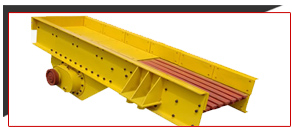| Manufacturer of : Jaw Crusher, Stone Crusher, Vibrating/ Rotary Screens, Conveyors, Truck Loaders & Quarry Equipments. |
Vibrating feeders are self-contained systems consisting of a bowl that orients the parts and a vibrating drive unit, upon which the bowl is mounted. The drive unit, equipped with a variable-amplitude controller, vibrates the bowl, forcing the parts to move up a circular, inclined track. The track is designed to sort and orient the parts in consistent, repeatable positions, according to certain requirements. The length, width and depth of bed of the vibratory feeder can be adjusted, and special bed liners can be installed if the material to be handled is abrasive. Dust-proof outlet covers can be attached to the inlet and discharge to reduce dusting caused by dusty material or a completely enclosed tube feeder can be specified. Vibratory feeders can also be manufactured from stainless steel to meet sanitary requirements in food processing. |
 |
1) flexible design
2) extra heavy-duty construction
3) exclusive vibrator technology
4) ease-of field-changes in grizzly opening and deck-slope |
Vibrating feeders are a variety of controls available for the different types of vibratory feeders. Pneumatic feeder controls include a quick-acting valve, an air line filter, a pressure regulator gauge, a lubricator and a long air hose. A transformer-type device, available for electromagnetic vibratory feeders, adjusts the intensity of vibration by varying the applied voltage. Electromechanical feeders have a wall-mounted control box with an on/off button or switch and overload protection. Special controls for remote operation include two speed, maximum-to-minimum material flow controls for batch weighing and panel board controls for multiple feeder installation. An accelerometer can be attached to the drive unit to monitor the amplitude and to apply a correction to the feeder, which tends to vibrate more quickly as the material level drops.
Vibratory feeders are utilized in the pharmaceutical, automotive, chemical and mining industries. Other industries include steel, glass, foundry, concrete, recycling, bakery, railroad unloading and plastics. Chemical plants typically use vibratory feeders to control the flow of ingredients to the mixing tanks. Foundries use them to add binders and carbons to sand reprocessing systems. The pulp and paper industry uses vibratory feeders for chemical additive feeding in the bleaching process, while the metal working industry uses them for feeding metal parts to beat treating furnaces. Vibratory feeders also are used by water and sewage treatment plants in chemical additive handling. Other materials that are separated by vibratory feeders include powder, plastic pellets, dry chemicals, coal, metals, ore, minerals, aluminum, mining and aggregates, grains, seed, dry detergents, ceramics, textiles, rubber, fibers, wood chips, salt, sugar and many, many more.
|
Vibrating Feeder Technical Data:
| Model |
Max.Feed Size(mm) |
Capacity (t/h) |
Power (kw) |
Weight (kg) |
Size of Funnel (mm) |
GZD850x3000 |
400 |
80-120 |
7.5 |
3607 |
850x3000 |
GZD960x3800 |
500 |
120-210 |
11 |
3895 |
1000x3600 |
GZD1100x4200 |
580 |
200-430 |
15 |
4170 |
1100x4200 |
GZD1100x4900 |
580 |
280-500 |
15 |
4520 |
4900x1100 |
GZD1300x4900 |
650 |
450-600 |
22 |
5200 |
4900x1300 |
GZD1300x6000 |
600 |
400~560 |
22 |
7500 |
6000x1300 |
GZD1500x6000 |
800 |
460~575 |
30 |
8666 |
6000x1500 |
GZD1800x6000 |
800 |
600~800 |
37 |
11800 |
6000x1800 |
|

